You know Robert Carlyle. From The Full Monty to Trainspotting to Cracker to 28 Weeks Later and, of course, as the golden-skinned Mr. Gold/Rumpelstiltskin on the hit ABC show Once Upon A Time, this talented Scotsman has created performances in both television and film which are indelible, varied, entertaining and award-winning. But now, Robert Carlyle moves behind the camera as writer/director of the deliciously dark comedy BARNEY THOMSON. And what do you know? He picks up a BAFTA Scotland Award for Best Feature Film for his efforts. And did I mention he also stars in the film? Robert Carlyle does indeed, have a golden touch.

And just who is BARNEY THOMSON? As Robert Carlyle describes him, Barney Thomson is a middle-aged barber who has always been kind of down on his luck. No girlfriend, no real interests, no ambition. He once had the front chair by the window in the barbershop. Sadly, as time has gone by, Barney has been moved farther and farther back in the shop until he’s behind a beaded curtain near the trash bins and water closet. The only place left for him to go is out the door, which is when we meet Barney. But, all is not completely abysmal. Barney does have his mother, Cemolina; a pain-in-the-neck nag whose greatest joys are gambling with the girls and insulting Barney.

Things are about to pick-up though, as thanks to a serial killer running around town mailing saran-wrapped body parts of his victims to their apparent loved ones. And for whatever reason, police inspector Holdall has set his sites on the hapless Barney as the killer.

While on location in Vancouver shooting Once Upon A Time, Robert Carlyle took time out to speak with me at length about BARNEY THOMSON, a project which he lovingly refers to as “stalking him” for years. There is a kindness and sincerity one hears in Carlyle’s voice that is telling; he is both humble and gracious. Thanks to his lovely Scottish brogue, an almost indescribable sense of whimsy and joy is infused into his words, escalating as conversation touches on filmmaking elements of which he is particularly proud. And proud is what he should be with his work behind the lens and in front of it on BARNEY THOMSON.
Either the idea wasn’t quite right or the script was ill-suited to Carlyle or the timing wasn’t right, but BARNEY THOMSON and Robert Carlyle never quite connected until now. Having been offered some films to direct over the years, Carlyle knew himself he wasn’t ready. Thanks to his years of acting experience, “I knew how difficult it actually is. I’d been fortunate enough to work with some fantastic directors through the years and watched and knew what it does to them and that it wears you down. And I knew it had to be something that I’m gonna enjoy.” Interestingly, BARNEY had already been offered to him “four or five times over a seven or eight year period as an actor to play the part. I liked it, but it just wasn’t quite right and I kept shying away from it.” But then the tables turned once he found himself in Vancouver working on Once Upon A Time.”
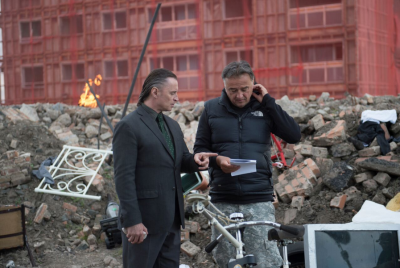
Some producers he knows blindly approached him with a project. “Look, we’ve got a Glasgow script you might be interested in”. Of course, the boy from Glasgow jumped at the chance to hear more. Laughingly he recalls, “And it was BARNEY THOMSON once more! I can’t get away from this film! It was kind of stalking me. BARNEY was stalking me!” But Carlyle knew he had to now take another look. “I had to get a look at it more deeply and say, ‘Why are you walking away from this? Why are you avoiding this?’ So I thought, ‘Why should I? The script is good. It’s set in Glasgow. But it’s not really a Glasgow that I recognize. It’s not even a Glasgow that I know.’ And John Lenic, my producer friend said to me, maybe that’s because it was written by a Canadian from Vancouver. [laughing] Aha! That’s it! That’s the key. So Rich Cowan, who’s a lovely guy, he had the screenplay, but he hadn’t gotten anywhere with it. He said, ‘Please take it away and do what you want to do with it.’.” Knowing that what the script needed was a rewrite from a Glasgow perspective, “myself and my good friend, Colin McLaren, we sat for the next 12 months, 18 months, putting it together into eventually what you see.”
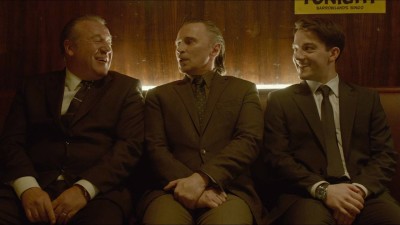
What Carlyle and McLaren came back with is a script that is sharp and funny and memorable. The next step was taking the page to the screen. Striking is the visual grammar of the film and the overall tonal bandwidth of the film. Visually, this film is dynamic and beautiful. The use of color is telling and adds its own layer to the film. Working with cinematographer Fabian Wagner, camera angles are varied, adding emotional texture while the frame design is simple, stripped down and focused. The overall results belies the work of a first time feature director. Carlyle gives full credit to Wagner for the work.
“Fabian was a wonderful help. He’s just fantastic. You can’t collaborate with anyone better than Fabian on this. When I developed the script, I’d seen it as a clear old-fashioned piece and I thought let’s kind of shoot it like that. Let’s make sure the camera’s isn’t spinning around. There’s no SteadiCam. Very few dolly shots. I wanted shots that are pretty much straight on with the actors looking straight at you.” Telling is that Carlyle’s biggest influence for the visual look of the film is American television circa 1955 to 1967. Admitting a “love for the golden age of television in the States. . .That period of tv drama was unique and quite stunning. Some wonderful wonderful ways that the guys back then put pieces together. It was more about let’s just tell the story. Let’s not be messing around too much with the camera. Let’s just compose beautiful shots and let the actors do the stuff within that. And that was the key for myself and Fabian all the way through. It was about let’s compose the beautiful shot and let’s not have so many set-ups, but let’s just stage one or two that we know are right and focus on that. Again, it’s such a big lot, so much money to do the film, and I can’t see how to do that any other way.”
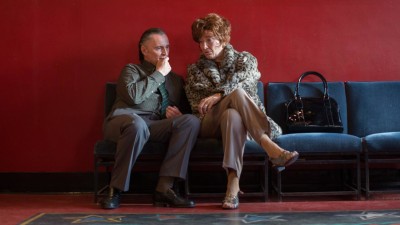
Once the visual design was established, “The film kind of then told it’s own story. The barbershop is, I guess, the heart of the whole film. My memory of barbershops when I was a kid in Glasgow – actually in any country – going into these places as a wee boy – they never really changed. The tunics that they wear, the cutters that they use. It’s all pretty much the same even to this day. I thought, that’s the key to the whole film. Outside in the street, the barber’s world can then blend itself out there – there’s no mobile phones, there’s no computers, there’s no nothing like that. . .but I don’t think you can linger on that for too long. It’s quite bare. The shots are quite bare. There are very few extras, there’s very few background in the long shots because I wanted you to see that foreground rather than see people walking by and cars flying by. . . .this isn’t going to be an action movie. I don’t want any of that. I want that actor.” The end result is a very clean look that goes beyond color saturation and the polish of the film. It’s unfettered with no eyeline distractions.
There is a visual poetry to BARNEY THOMSON, much of which comes from the use of color. Burnished reds and darker woods at a gritty timelessness to the barbershop which is then off-set by the pure white sterility of the apartment of fellow barber Chris and the cream-beige of Cemolina’s home. Each decision was deliberate.

According to Carlyle, “That look, that feel, the reds – it’s a burgundy – comes through quite strong, and also the browns like a tobacco, add a quality to that. . .I wanted to give it that kind of older look. And greens as well. There’s something quite interesting about red and green together or pink and green. These colors to me, there’s a marriage. And we tried to do a lot of it. The sequences just ring on these tones. Then when you get to Cemolina’s house, there’s kind of cream, it’s kind of beige. That beige cream kind of world you see at your grandparents. Wall to wall!” By muting Cemolina’s color palette in the home, it then allowed the character to be front and center with vibrant floral patterns in her clothing, the color in her hair. The white-on-white high tech look of Chris’ home adds a new dimension to Chris that we don’t see while he’s in the barbershop. “I was trying to kind of repulse Barney even more by Chris. Because he hates Chris because Chris is probably everything that he never was and probably everything he wanted to be.”
A touch of special effects comes into play in moments where Barney goes inside of himself and confusing memories come to light with burgundy red blood rain dripping down in the background. As Carlyle describes the effect, “That was something to just kind of say to Barney, you’ve seen this before. You’ve been in this house so many times with your mother. You’ve see that, lad. You’ve watched all this. And suddenly he just sees it all anew in that moment when he pieces it all together. He kind of pieces the whole thing together in that room and realizes his mother was really this monster.”
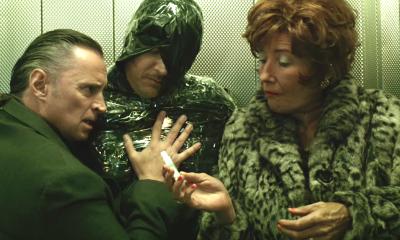
Speaking of “this monster”, the conversation turns to Emma Thompson and her performance as Cemolina. Quickly admitting, “What a professional she is. From start to finish. She just grabbed that part with both hands. To use an American expression, she knocked it out of the park.”, Carlyle explained the how and why of Emma Thompson coming to BARNEY THOMSON. “I had hoped that she would react the way she did to the script. There’s a lot of story behind the reason I went with Emma. I knew that I needed someone brave to play this part because the character Cemolina is generally for a guy. Guys are so crazy and off the wall when they play this type of part. . .So I thought, who’s gonna be brave enough to take this on. And you look at Emma. Then you look at the way she looked in the film and there’s someone who has no vanity, who’s in this for the art.” But it’s how the part came to Emma Thompson that speaks unspoken volumes about both Robert Carlyle and Emma Thompson. “Many many years before, I think about the time of The Full Monty, this card came to my door. Not through my agent. It just came to my door and it was from Emma. I’d never met Emma Thompson but it was from Emma saying ‘I’d loved the film. Well done. I’m so proud of you. Blah, blah, blah.’ Just a beautiful unsolicited thing. And I thought, I’m gonna get the chance one day to repay that kindness of that card. Cemolina was, in a sense, my repayment of that. When I sent the script to Emma, I put in a little cover letter of telling her that, and she replied and accepted the part within a day and a half. And we had Emma Thompson on board. There was a big celebration in the production office that day.”

But the casting riches of BARNEY THOMSON continue with Ray Winstone who gets to strut his comedic stuff to great aplomb. According to Carlyle. “ Ray and I are great buddies and I think Ray is terrific with comedy. Like myself, he often gets cast as the villain, this psychotic kind of character in films and stuff. I knew that Ray had comedy in his blood. He captured it. He did an excellent job on it.”
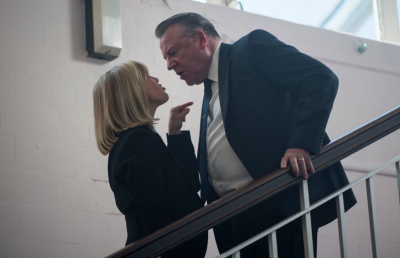
The big question, however, revolves around Robert Carlyle’s dueling hats of actor vs. director, which can often be problematic when it’s one in the same person. Calling on planned preparation knowing he would be both actor and director, plus his own years of experience in front of the camera, Carlyle was at the top of his game and able to pull off the feat. “Number one, myself and Colin kind of structured the script in such a way that Barney’s very reactive. He doesn’t really follow the plot so much. Everything kind of happens about, and things happen to, Barney. So it’s mostly kind of reactive. . . In comedies, in dark comedies, it doesn’t take a performance where you’re pulling your heartstrings apart. The second thing was I had a wonderful stand-in, although he wasn’t a stand-in, a wonderful friend, a Glasgow actor friend of mine named Mark Barrett. . . .Emma and Ray and all the rest of the cast, had the opportunity to have four or five times of takes with Mark while myself and Fabian were setting up the shots and getting them right. And then once we’d done that, then I would go in.”

Some good tips for all actor/directors are lessons learned by Robert Carlyle. “ Most of the time, to be honest, most of my takes when the camera went on were one or two takes. Very very quick. Get it done. Get it over with. And don’t think about it too much. Don’t be sitting there in your own head parked. You don’t have that luxury. You’ve got to be broader than that and bigger than that. That, and something I learned, it is achievable.” Carlyle also imparted a little wisdom from his time on the set of “Once Upon A Time”. “[Y]ou very quickly have to become your own arbiter of what you’re doing. You know yourself whether the take is right and whether it’s correct or not. So the fact I was doing this kind of work leading up to shooting BARNEY was wonderful. That was the key. . .I had one little monitor in the back of my head which has always been there through Once Upon A Time, and starting out on this, I think one of the greatest reasons of why I was able to do it.”
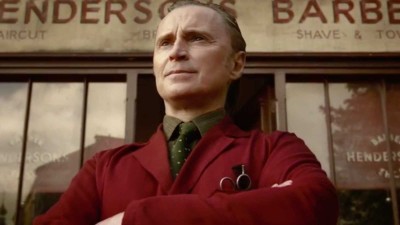
Having completed BARNEY THOMSON, already to award-winning, critical and audience acclaim, it’s time to reflect before moving on to the next inevitable directorial effort and begs the question, what did Robert Carlyle learn about himself in the process of directing this film? With a hearty genuine laugh, his candor is charming. “I’m crazy!” But turning serious, Carlyle is beyond thoughtful and humble. “Actually, that I could do it. I’ve been incredibly fortunate, Debbie. I’ve worked with some amazing wonderful directors through the years. People like Danny Boyle, Alan Parker, Ken Loach. I hope that I have taken from them. You hope that all the years I’ve been in front of the camera had rubbed off a little. I think what BARNEY’s taught me is that it did. It has. And that it was possible for me to do this. Back in my theatre days, I worked in the theatre for 4 or 5 years and then I actually started to direct. I directed in the theatre for about 6 or 7 years. So the thing of it about directing the actors was never a problem. It was never an issue. What was going to be an issue was can I put this vision that’s in my head, on the screen. That was the key. And of course with the wonderful help of Fabian, I was able to do that.”











